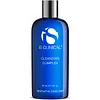What's inside
What's inside
 Key Ingredients
Key Ingredients

 Benefits
Benefits

 Concerns
Concerns

 Ingredients Side-by-side
Ingredients Side-by-side

Water
Skin ConditioningPoloxamer 184
EmulsifyingAmmonium Polyacryloyldimethyl Taurate
Emulsion StabilisingDecyl Glucoside
CleansingSodium Polyacryloyldimethyl Taurate
Emulsion StabilisingGlycerin
HumectantPolyglyceryl-3 Cocoate
EmulsifyingPolyglyceryl-4 Caprylate/Caprate
Polyglyceryl-4 Laurate/Sebacate
SolventPolyglyceryl-6 Caprylate
EmulsifyingPolyglyceryl-6 Ricinoleate
EmulsifyingSorbitan Sesquioleate
EmulsifyingCitric Acid
BufferingSodium Phytate
Phenoxyethanol
PreservativeSynthetic Fluorphlogopite
Tin Oxide
AbrasiveTitanium Dioxide
Cosmetic ColorantWater, Poloxamer 184, Ammonium Polyacryloyldimethyl Taurate, Decyl Glucoside, Sodium Polyacryloyldimethyl Taurate, Glycerin, Polyglyceryl-3 Cocoate, Polyglyceryl-4 Caprylate/Caprate, Polyglyceryl-4 Laurate/Sebacate, Polyglyceryl-6 Caprylate, Polyglyceryl-6 Ricinoleate, Sorbitan Sesquioleate, Citric Acid, Sodium Phytate, Phenoxyethanol, Synthetic Fluorphlogopite, Tin Oxide, Titanium Dioxide
Water
Skin ConditioningDisodium Laureth Sulfosuccinate
CleansingCocamidopropyl Betaine
CleansingPEG-30 Glyceryl Cocoate
EmulsifyingGlycerin
HumectantPropylene Glycol
HumectantHydroxyethylcellulose
Emulsion StabilisingSalix Alba Bark Extract
AstringentSaccharum Officinarum Extract
MoisturisingCamellia Sinensis Leaf Extract
AntimicrobialChamomilla Recutita Flower Extract
MaskingAsiaticoside
AntioxidantAsiatic Acid
Skin ConditioningMadecassic Acid
Skin ConditioningAscorbyl Palmitate
AntioxidantPhospholipids
Skin ConditioningTocopheryl Acetate
AntioxidantRetinyl Palmitate
Skin ConditioningIodopropynyl Butylcarbamate
PreservativePhenoxyethanol
PreservativeWater, Disodium Laureth Sulfosuccinate, Cocamidopropyl Betaine, PEG-30 Glyceryl Cocoate, Glycerin, Propylene Glycol, Hydroxyethylcellulose, Salix Alba Bark Extract, Saccharum Officinarum Extract, Camellia Sinensis Leaf Extract, Chamomilla Recutita Flower Extract, Asiaticoside, Asiatic Acid, Madecassic Acid, Ascorbyl Palmitate, Phospholipids, Tocopheryl Acetate, Retinyl Palmitate, Iodopropynyl Butylcarbamate, Phenoxyethanol
 Reviews
Reviews

Ingredients Explained
These ingredients are found in both products.
Ingredients higher up in an ingredient list are typically present in a larger amount.
Glycerin is already naturally found in your skin. It helps moisturize and protect your skin.
A study from 2016 found glycerin to be more effective as a humectant than AHAs and hyaluronic acid.
As a humectant, it helps the skin stay hydrated by pulling moisture to your skin. The low molecular weight of glycerin allows it to pull moisture into the deeper layers of your skin.
Hydrated skin improves your skin barrier; Your skin barrier helps protect against irritants and bacteria.
Glycerin has also been found to have antimicrobial and antiviral properties. Due to these properties, glycerin is often used in wound and burn treatments.
In cosmetics, glycerin is usually derived from plants such as soybean or palm. However, it can also be sourced from animals, such as tallow or animal fat.
This ingredient is organic, colorless, odorless, and non-toxic.
Glycerin is the name for this ingredient in American English. British English uses Glycerol/Glycerine.
Learn more about GlycerinPhenoxyethanol is a preservative that has germicide, antimicrobial, and aromatic properties. Studies show that phenoxyethanol can prevent microbial growth. By itself, it has a scent that is similar to that of a rose.
It's often used in formulations along with Caprylyl Glycol to preserve the shelf life of products.
Water. It's the most common cosmetic ingredient of all. You'll usually see it at the top of ingredient lists, meaning that it makes up the largest part of the product.
So why is it so popular? Water most often acts as a solvent - this means that it helps dissolve other ingredients into the formulation.
You'll also recognize water as that liquid we all need to stay alive. If you see this, drink a glass of water. Stay hydrated!
Learn more about Water